Welcome to part two of four of my Top Toys series! To read more about why I am doing this series, please check out Part One Here.
I am writing these posts to help parents pick good, quality toys for their infants, toddlers and preschoolers that can be used to help support speech and language development. As I share with you my personal top picks for toys for infants, toddlers and preschoolers, I will also be sharing the areas of speech and language that these toys can help support. However, as I noted in part one, it is important to know that for these toys to help support speech and language development you, as the parent or caregiver must help to facilitate that language. What I mean is this: You can’t just give a child a shape sorter and expect him to magically know and use the names of shapes and colors! You need to sit with your child and facilitate his learning. You need to use some strategies that I have mentioned before including:
Parallel Talk, Self Talk, & Descriptions
Expansions, Extensions, and Repetitions
Commenting and Asking Questions
If you are a fellow speech pathologist and work with infants, toddlers or preschoolers, you may also find this series of posts valuable for choosing therapy materials.
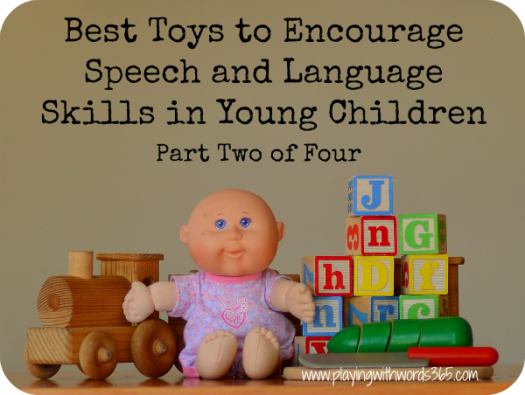
Here are my next five top picks for toys (in no particular order)
Baby Doll
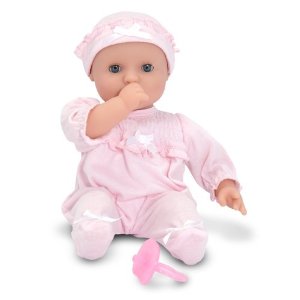
The baby doll is such a fantastic toy that I wish ALL children (Yes, even BOYS!) can have. It is a toy that can really help open up and expand a child’s pretend play. Let’s look at just some of the language concepts that a baby doll can help teach and support:
- Body Parts: Use the dolls to teach all the body parts: eyes, nose, mouth, ears, hands, fingers, tummy, feet, toes, knees, elbows, etc.
- Clothing Labels: Using the doll and its clothes, you can teach the names of clothing items like shirts, pants, shoes, socks, jammies, etc.
- Basic Concepts: Use baby with other baby toys (bed, blankets) to teach some basic concepts like: prepositions (baby in the bed, baby under the blanket), colors, size concepts (using different sized dolls),
- Verbs/Feelings: Use the baby with some other baby toys (bed, bottle, clothes) to teach verbs/feelings/etc. like: eat, drink, sleep, sit, stand, hungry, sleepy, thirsty, etc.
- Answering “wh” questions: You can ask your child an array of questions to work on her understanding of these words. Where is baby? Where is baby’s nose/fingers/belly button? What does the baby want to eat? Why is the baby crying?
- Social/pragmatic skills: Baby dolls can be a great tool to use to help teach appropraite social/pragmatic skills. Take turns playing with different dolls. Practice using language to ask questions about the dolls and what they are doing.
Baby stroller and/or grocery cart
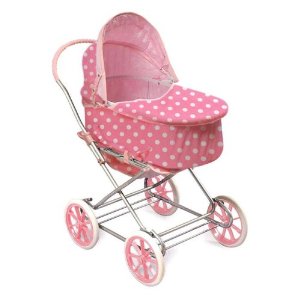 I decided to put these toys together because in reality, they can be used interchangeably in a lot of play pretend play. My own children actually have both of these toys and inevitably babies end up in the shopping cart and play food ends up in the stroller (not to mention all kids of other…interesting items). Think these toys are expensive? They don’t have to be! My daughter got her first stroller as a gift but you can find them for $10 at Target. We ended up getting her grocery cart FILLED with fake food for only $5 on sale at Toys R US! Also check out garage sales and second hand stores for great deals. Let’s look at just some of the language concepts that the doll stroller and/or grocery cart can help teach and support:
I decided to put these toys together because in reality, they can be used interchangeably in a lot of play pretend play. My own children actually have both of these toys and inevitably babies end up in the shopping cart and play food ends up in the stroller (not to mention all kids of other…interesting items). Think these toys are expensive? They don’t have to be! My daughter got her first stroller as a gift but you can find them for $10 at Target. We ended up getting her grocery cart FILLED with fake food for only $5 on sale at Toys R US! Also check out garage sales and second hand stores for great deals. Let’s look at just some of the language concepts that the doll stroller and/or grocery cart can help teach and support:
- Food vocabulary: When used with some simple, inexpensive fake food, you can teach the names for all KINDS of food items. IKEA and Target both sell really inexpensive fake foods.
- Basic Concepts: Using baby dolls, food, and any other items, you can work on concepts like in, out, on, under, between, next to, etc. You can work on full/empty, some/most/all, first/then/last, big/medium/small, big/bigger/biggest, etc. You can push the m THROUGH things and AROUND things and BETWEEN things (like chairs, furniture, and other toys).
- Verbs: While playing with these toys you can work on the words push, stop, go, run, walk, jump, skip, etc.
- Answering “wh” questions: Work on answering Who, What, Where, Why, When, and How while you play with the cart/stroller. Where are you going? Where is the baby? Where is the food? What color is the apple?
- Social/pragmatic skills: You can use these items to work on turn taking, a very important social skills. Take turns putting things in, taking things out, and pushing them around the house.
Cars/Trucks/Trains
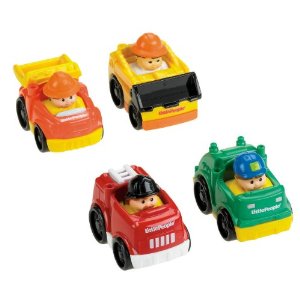 Here is another toy that I believe all children should have despite their gender. Girls should have at least a couple toy cars and/or trains too! My daughter was actually really into trains for a while, but has now converted to all things girl: princesses, princesses and more princesses! Let’s look at just some of the language concepts that toy cars can help teach and support:
Here is another toy that I believe all children should have despite their gender. Girls should have at least a couple toy cars and/or trains too! My daughter was actually really into trains for a while, but has now converted to all things girl: princesses, princesses and more princesses! Let’s look at just some of the language concepts that toy cars can help teach and support:
- Basic Concepts: You can basically work on all the major basic concepts using cars. Pair the cars with a simple ramp that you can make out of cardboard or wood and you can basically target anything you want! You can target colors, numbers (if they have numbers on the cars), counting, big/small, some/more/less/all, fast/slow, all the propositional concepts like in/on/under/over/top/bottom etc.
- Part/whole relationships: Cars are great for teaching part/whole relationships. Work on naming all the different parts of the cars: Wheels, windows, bumpers, doors, etc
- Verbs and Adjectives: Cars are great for working on all kinds of action and describing words! Go, stop, fast, slow, etc.
- Social/pragmatic skills: You can use these items to work on turn taking, a very important social skills. Take turns racing the cars on the floor or down a ramp. Take turns playing with different cards. Practice saying “My turn” and “May I have that car please?”
- Answering “wh” questions: Work on answering Who, What, Where, Why, When, and How while you play with the cars. Where is the car? Who is driving the car? What color is the car? Where are the wheels?
Farm Set
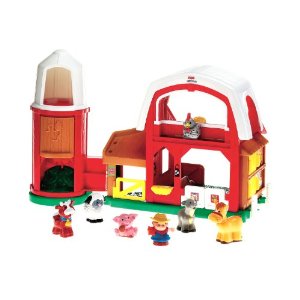 Ahhhh yes. The Farm set. If this isn’t a staple in your home/preschool/child care center/therapy tool box it should be. Let’s look at just some of the language concepts that the doll stroller and/or grocery cart can help teach and support:
Ahhhh yes. The Farm set. If this isn’t a staple in your home/preschool/child care center/therapy tool box it should be. Let’s look at just some of the language concepts that the doll stroller and/or grocery cart can help teach and support:
- Animal Names and Animal Sounds: Work on teaching the names of all the animals and the sounds they make!
- Basic Concepts: Using the animals and the barn, you can work on all the prepositional concepts like in, out, on, under, between, next to, etc. You can work on some/most/all, first/then/last, big/medium/small, big/bigger/biggest, etc. and all the colors.
- Answering “wh” questions: Work on answering Who, What, Where, Why, When, and How while you play with the animals. Where is the horse? Which animal is next to the cow? Who is eating? Which animal makes the Mooooo sound? Etc.
- Social/pragmatic skills: You can use these items to work on turn taking, a very important social skills. Take turns with the animals. Work on asking “May I have a turn please?” or “May I have the horse please?” Work on eye contact while you play and talk.
Mr. Potato Head
 Another classic toy, Mr. Potato Head can help teach SO MANY language concepts and vocabulary! This is one of the first toys that I bought when I started working with preschool children. I have also used Mr. Potato Head with young elementary school children to work on basic concepts and following directions in a Barrier Game Format. Let’s look at just some of the language concepts that the doll stroller and/or grocery cart can hep teach and support:
Another classic toy, Mr. Potato Head can help teach SO MANY language concepts and vocabulary! This is one of the first toys that I bought when I started working with preschool children. I have also used Mr. Potato Head with young elementary school children to work on basic concepts and following directions in a Barrier Game Format. Let’s look at just some of the language concepts that the doll stroller and/or grocery cart can hep teach and support:
- Body Part Names: Obviously Mr. Potato Head is excellent for teaching body part names. Just be sure to teach the child the body part names on her own body as well.
- Clothing Item Names: Mr. Potato Head also comes with many different clothing items and accessories. This is a great way to teach items like earrings, purse, hat, etc. If you purchase multiple sets you can have different types of items to target also. For example you can get ones at Halloween time and target the different costumes. You can even get Santa ones at Christmas! (We have a Santa one and my daughter LOVES it!)
- Basic Concepts: Mr. Potato Head is great for working on all color concepts as well as the concepts of in/out. You can also work on concepts such as first/next/last and left/right and prepositional concepts like over/under/top/bottom etc.
- Social/pragmatic skills: You can use these items to work on turn taking, a very important social skills. Take turns with the animals. Work on asking “May I have a turn please?” or “May I have the horse please?” Work on eye contact while you play and talk.
- Answering “wh” questions: Work on answering Who, What, Where, Why, When, and How while you play with the cars. Where is the car? Who is driving the car? What color is the car? Where are the wheels?
There are my next 5 recommendations! Check out the links below for my other 15 picks!
Best Toys for Speech & Language Development: Part One
Best Toys for Speech & Language Development: Part Three
Best Toys for Speech & Language Development: Part Four
Cheers!
Great list! Thanks!! And I am on the lookout for fake food!
Thanks Christina! Also check places like Ross, Marshalls and TJMaxx for fake food…you can sometimes find awesome deals!
I love this list. These are things we already have but it gives me more ideas for conversations during play. my 2 year old– who doesn’t talk much– LOVES toys. He can stay entertained for a long while with his little people sets and his trucks! He does have one baby but he doesn’t play with it much. He loves to put it to bed. 🙂 We’ll have to try dressing it, etc.
Jackie I am so glad you are finding it helpful! Yeah…not all kids will like all toys so it’s ok if your son isn’t into the doll 😉 And their interests change so quickly too!!
This is such a great post! I am an SLP working in an outpatient setting. The majority of therapy is in a play based/child directed manner. I am already using a majority of the toys you have listed but this post was very helpful in expanding the way I am using the toys and the different language components I can target that I am not already focusing on! thanks!
Thanks Stephanie, I am so glad you are enjoying it! Stay tuned…I have a giveaway planned to go along with this series of articles!
I have worked as an SLP with Birth-grade 12 students for 12 years now, and have 3 girls of my own…I whole-heartedly agree on ALL of your recommendations so far! In fact, I think at home we OWN each of the items you have mentioned! I look forward to seeing what other items I may be missing as you continue your posts. Wonderful information for families or SLPs who are not sure on what to use or how to use it. Thanks for such a wonderful group of postings!
Casey, THANK YOU! It means SO much to hear this from a fellow SLP (and mama!). We also own all these toys at home! 😀
Thanks! Sofia got to play with some fake food last week at our friend’s house and she loved it! I’m going to get her some very soon.
Awesome Jamie!
Wonderful list! Pinning this one.
Susan Case recently posted..ARK – Acts of Random Kindness for Kids & Adults with Free Printables
I enjoyed reading your post. I am a preschool teacher and use many of these items in my classroom. It is not always necessary to purchase all the commercialized play food at a store. I often add empty food containers (cereal boxes, cracker boxes, milk cartons, tin cans, juice containers, egg cartons, etc.) to the house centre in my classroom. You can also add dry food in containers (items like pasta, and nuts). Cut up yarn is a great way to simulate spaghetti. The children then can relate to the real dramatic play items in a concrete, authentic way, because they see the items being used in their homes and at school. The bonus is that you save money when don’t have to buy the toy food.
Chantelle those are fantastic ideas! Thanks so much for the recommendations!
Katie,
I teach Deaf and Hard of Hearing children.You have wonderful ideas and information. This is helpful for others working with my students and parents. I appreciate your willingness to share your expertise.
Thank you so much for this list. I’ve been having a really hard tme figuring out how to better introduce our 17m old daughter to language and these series of posts are really helping!! I’m a communicator, I learn/do everything through words but she seems to learn things more by physically doing/manipulating the objects. She chatters a lot of baby babble but she doesn’t seem interested in much talking and its really frustrating the both of us!! I can’t seem to play/interact very well with her at the moment and everything I do just results in her screaming. She really does not have the right toys either, something I will work on changing by following your posts. Could you add a post of how to use all these items?? I know most of them seem self explanatory but with a toddler who just does not want to listen/talk I just don’t know what to do! For example my natural inclination with the baby doll would be to give her a small box and do a pretend bed time routine, push the doll around in a toy stroller, use the baby doll to point out body parts ect but when I do these things she just seems to get angry and frustrated at me for getting involved! Am I doing the wrong thing? Thank you for any advice, I feel like a fish out of water here 🙁
Bec, welcome! I am happy to hear you are finding my posts helpful. As far as how to use the toys, I encourage you to check out my How to Help your Child Talk page, and start reading my How to Help Your Child Talk series. The most important thing to do is follow your child’s lead. One quick recommendation regarding the baby doll…get yourself your OWN doll, and feel free to play with it as you wish along side your daughter, and then allow your child to play with her doll as she wishes. Don’t label body parts…just PLAY 🙂 Good luck!
Hi, I have a grandson that was born 6 weeks early. His pediatrician is now saying my grandson needs speech therapy…he is 15 months old. I was curious to ask how would she know that my grandson needs speech therapy at such a young age? He says Da Da and Da Dee…Mommy…he is getting ready to walk, very intelligent when it comes to showng him something once and he mimics it immediately. I would like to help my daughter in law not be so nervous about it. Thank you.
Love your website wonderful wonderful teaching strategies for special ed students too
WOW I just want to thank you so much for this information! I’m currently undergoing speech therapy with 2 and half year old and I’m literally buying every toy that can help encourage speech nd i can join in too thanks